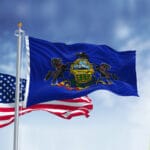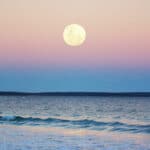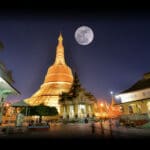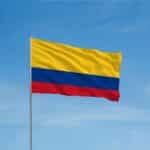We celebrate Space Exploration Day every year on July 20. Also known as National Moon Day, President Ronald Reagan created this holiday to commemorate the first crewed mission to the moon and moon landing, which took place on July 20, 1969. Eight years after President John F. Kennedy set a goal for America to land on the moon before the end of the decade, the Apollo 11 mission succeeded. The day also seeks to inspire and encourage young people to pursue careers in space sciences and space exploration. So, let’s look to the heavens and remember the incredible space advances humanity has made thus far, and dream of where we will still go.
History of Space Exploration Day
On July 16, 1969, NASA’s Apollo 11 mission launched from the Kennedy Space Center in Florida, U.S.A. There were three astronauts aboard the rocket ship — Neil Armstrong, Edwin ‘Buzz’ Aldrin, and Michael Collins. At 1:46 p.m. on July 20, the lunar module nicknamed the ‘Eagle,’ carrying only Aldrin and Armstrong, separated from the command module where Collins was.At exactly 10:56 p.m. on that day, Armstrong became the first human to set foot on the moon as he descended from the ladder, making the famous quote that is now known all over the world: “That’s one small step for man, one giant leap for mankind.” In reality, Armstrong claimed that he actually said, “That’s one small step for a man, one giant leap for mankind.” His words were garbled by the microphone he was using. Nineteen minutes later, Aldrin also planted his boots on the moon’s surface.For the next several hours, both men planted the U.S. flag, took photographs of the surroundings, and even communicated with President Richard Nixon. That night, Aldrin and Armstrong slept in the lunar module on the moon’s surface. By 1:45 p.m. on July 21, the Eagle began its ascension back to the other module, successfully rejoining it about four hours later. Finally, on July 22 at 12:56 a.m., the journey back to Earth commenced, and Apollo 11 made a safe splash into the Pacific Ocean on July 24, at 12:50 p.m.
Space Exploration Day timeline
President John F. Kennedy sets a goal for America to land a man on the moon before the end of the decade.
Man sets foot on the moon for the first time in history.
July 20 is proclaimed Space Exploration Day and a holiday by President Ronald Reagan.
SpaceShipOne, the first private crewed spacecraft, flies past the boundary of space on June 21, 2004.
Space Exploration Day FAQs
Why is space black?
Space is a nearly perfect vacuum, and there is almost nothing in the space between stars and planets to scatter light; that’s why our eyes only see black.
What is National Space Day?
National Space Day is celebrated on the first Friday in May to inspire us to pursue knowledge and progress. The Lockheed Martin Corporation started National Space Day in 1997, but it was expanded to International Space Day in 2001 by former astronaut and senator John Glenn.
How long is a Space Day?
Time in space is complicated, but most sources say that a day on the Moon lasts about 29.5 Earth days.
Space Exploration Day Activities
-
Visit a space museum
On this day, visit a local space museum. Learn more about how our planets work and the fascinating history of space exploration.
-
Celebrate astronauts
What better way to spend the day than to celebrate the incredible work of astronauts. They have an uphill task of discovering our universe and are so kind to let us share in their knowledge and experience.
-
Share what you learn
Did you find anything interesting while researching space exploration? Share it with everyone you know! Make a post, tag your friends, and use the hashtag #SpaceExplorationDay!
5 Important Facts About Neil Armstrong
-
Birth
Neil Alden Armstrong was born on August 5, 1930, in Wapakoneta, Ohio.
-
Education
Sponsored by the United States Navy, he studied aeronautical engineering at Purdue University, Indiana, and graduated in 1955.
-
NASA
He joined the NASA Astronaut Corps in 1962 and made his first spaceflight as the command pilot of Gemini 8 in 1966.
-
Awards
Among many others, Armstrong was awarded the Presidential Medal of Freedom by President Richard Nixon.
-
Death
Armstrong died at the age of 82 after an unsuccessful coronary bypass surgery.
Why We Love Space Exploration Day
-
It commemorates a significant achievement
This holiday celebrates the significant moment in history when America was the first country to land humans on the moon. It’s a glorious example of American ingenuity and advancement.
-
It recognizes space exploration workers
Today also shines the spotlight on a field that is rarely spoken of. This day allows us to celebrate the work of thousands of nameless, behind-the-scenes people who work tirelessly to make space missions a success. They all deserve to be recognized and honored for their commitment, brilliance, and bravery.
-
It encourages space careers
This day not only recognizes and celebrates the past work of astronauts, scientists, engineers, etc., but it also paves the way for future interest in the field. With all the awareness activities related to Space Exploration Day, the day will inspire more young people to pursue space-centered careers.
Space Exploration Day dates
| Year | Date | Day |
|---|---|---|
| 2023 | July 20 | Thursday |
| 2024 | July 20 | Saturday |
| 2025 | July 20 | Sunday |
| 2026 | July 20 | Monday |
| 2027 | July 20 | Tuesday |






















